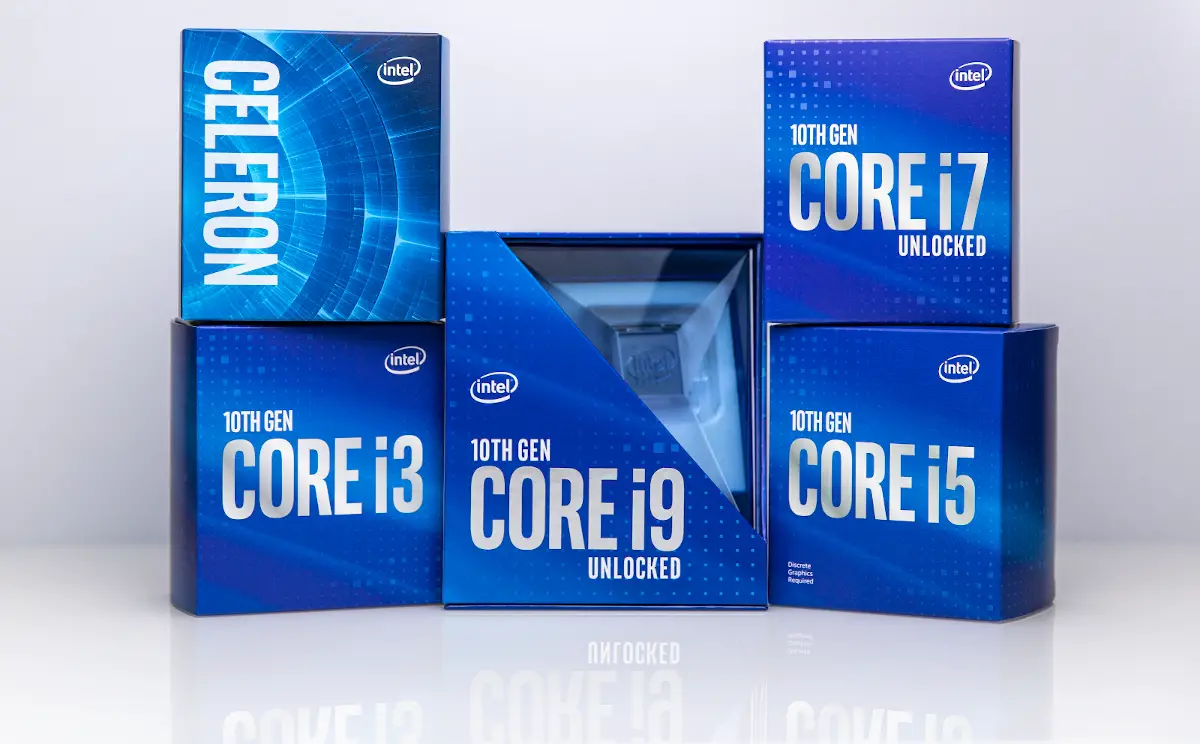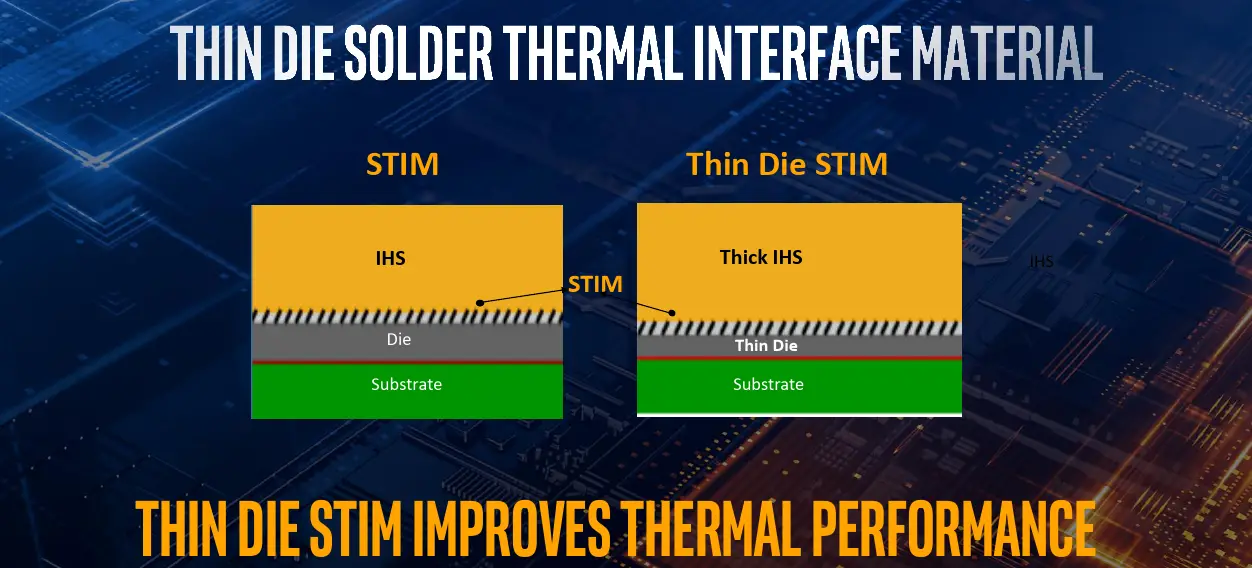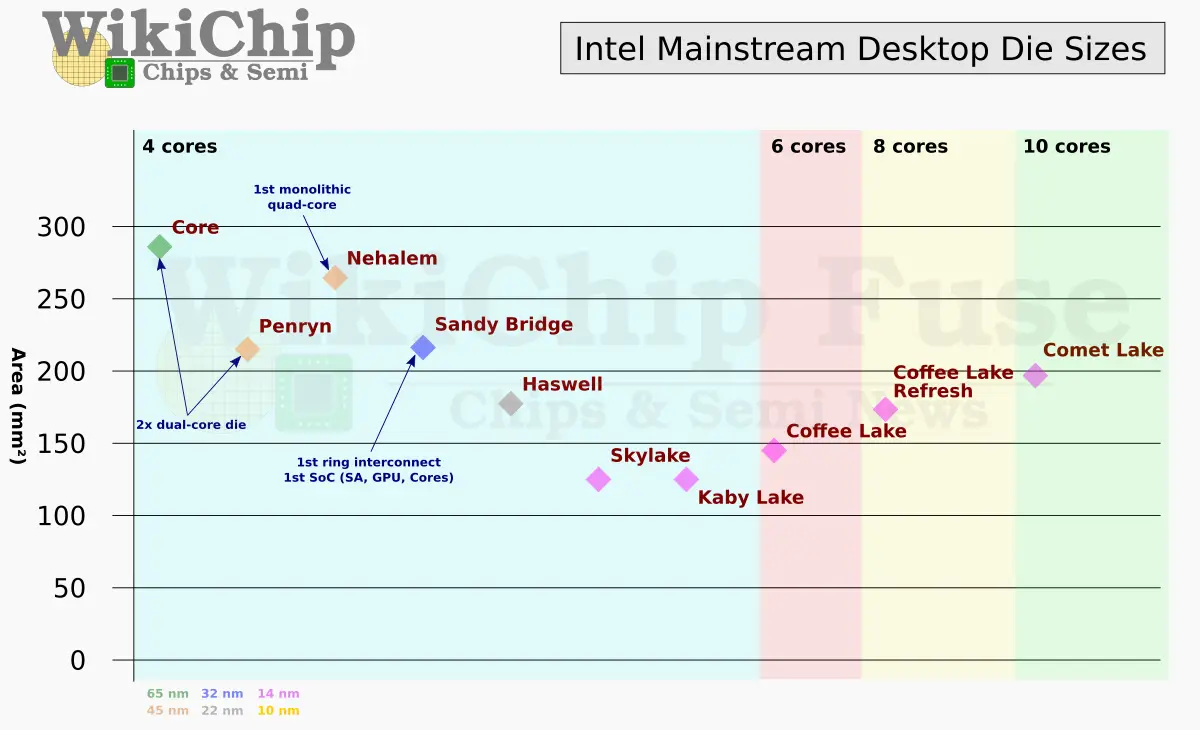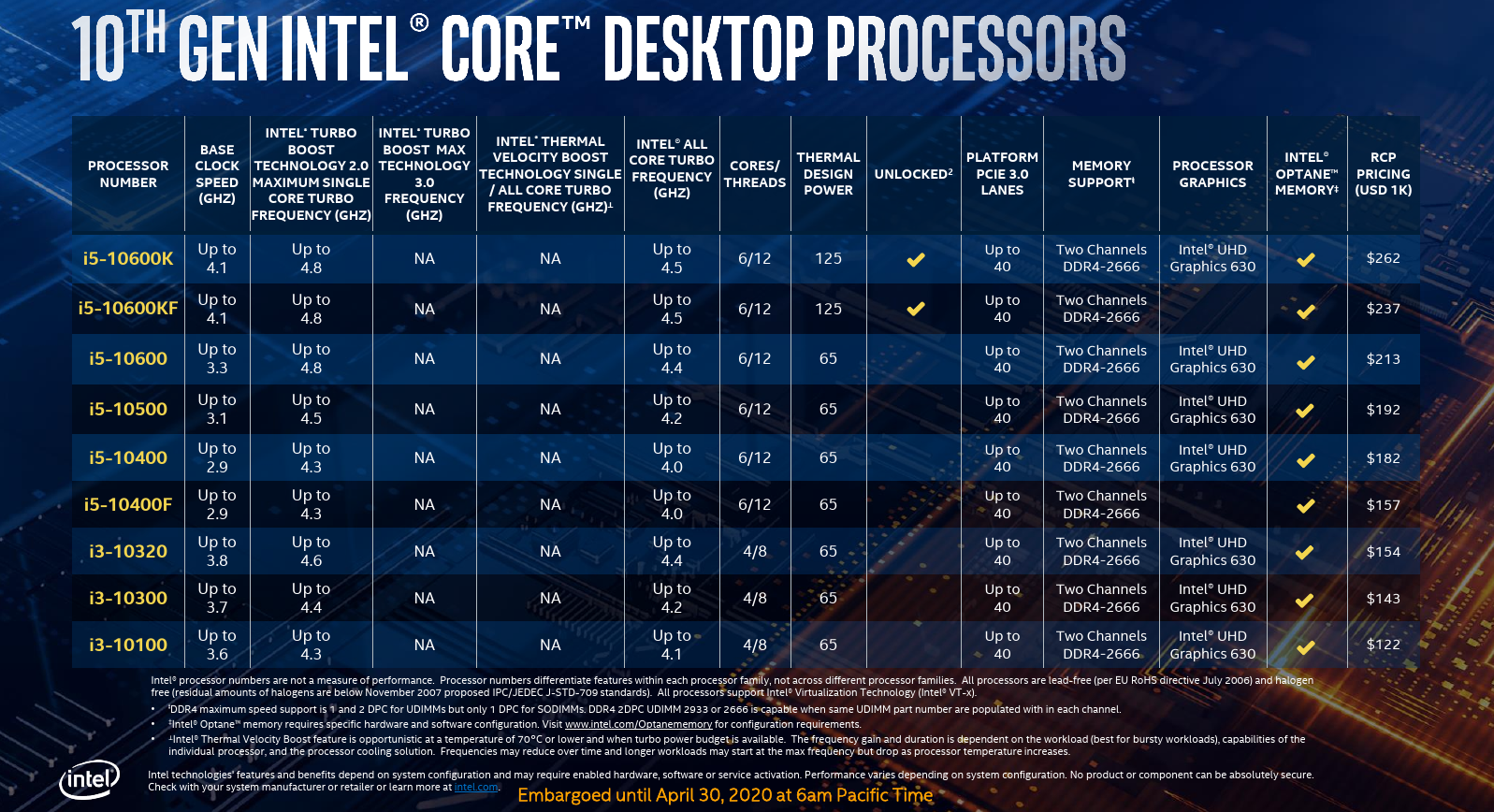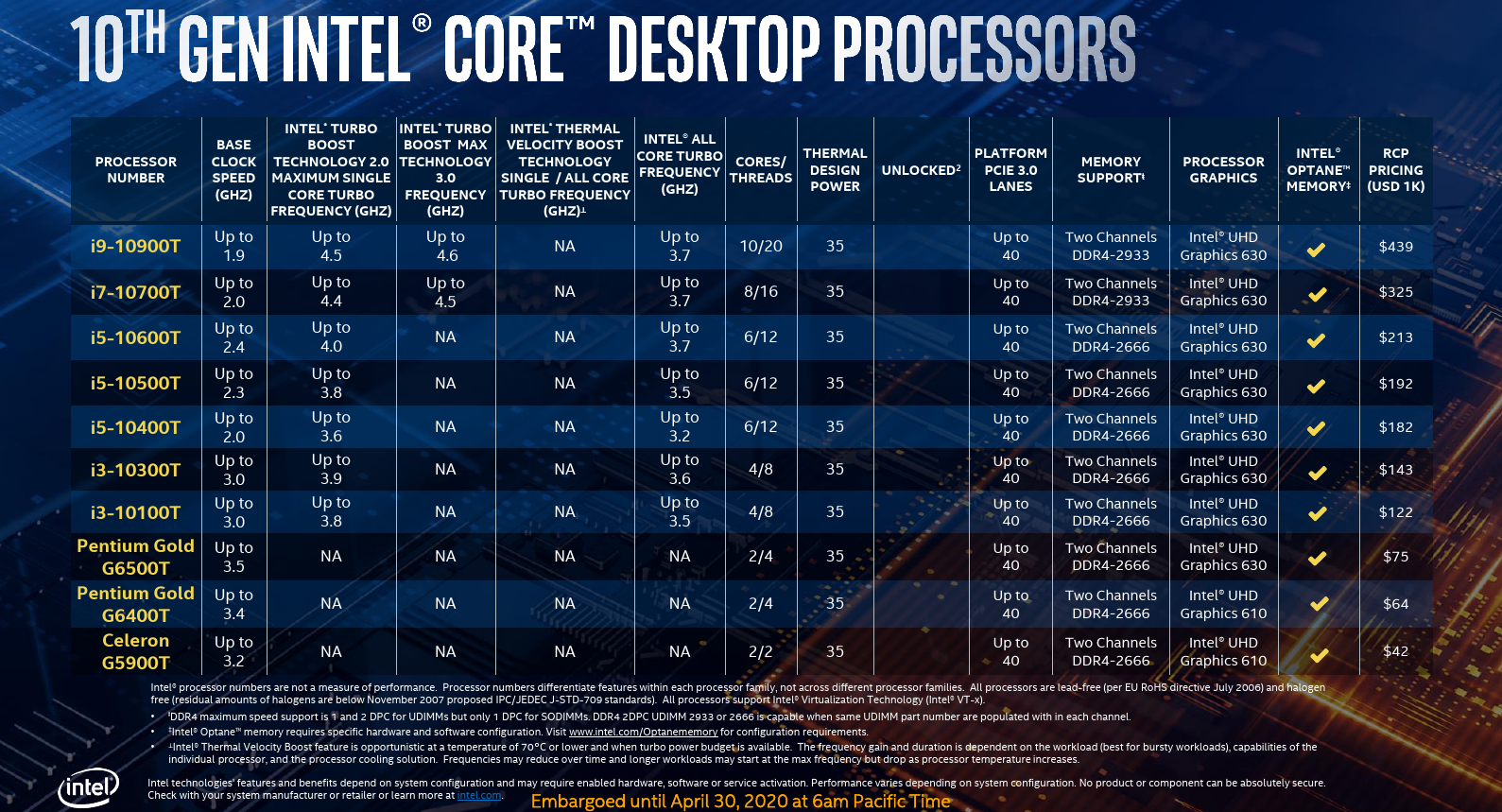Intel Launches 10th Gen Comet Lake Desktop Processors
Continuing with its roll-out of the company’s latest Comet Lake processors, today Intel is launching its entire desktop lineup. The launch effectively ends what has been the company’s longest cadence in recent times, finally replacing 9th Gen desktop processors that were originally launched back in October 2018. The new lineup introduces a number of changes over the prior generation improving not only single-thread and multi-thread performance, but also the performance per dollar.
More Cores, More MHz, Similar Prices
The new 10th Generation desktop processors are still fabricated on the company’s high-performance 14-nanometer (14++) process which essentially means they are still a tweaked Skylake part. There are, however, a number of nice changes that were made to the lineup. The first one is the core count. Whereas the last generation integrated up to eight cores, the new SKUs have been extended to ten cores. Perhaps just as importantly, Intel brought back hyperthreading across the entire lineup – all the way to value Pentium Gold SKUs. This is incredibly important since Intel dropped hyperthreading on the prior generation of Core i7s and the lower-end SKUs which meant highly threaded workloads were disadvantaged on those processors. In fact, on some chips, it was even possible to experience a regression in multi-threaded performance gen-over-gen. This is entirely fixed with this generation of processors. On the high-end parts, the official specs for the memory controller have also been bumped from DDR4-2666 to DDR4-2933, offering 10% higher peak memory bandwidth. Finally, in order to improve both single-threaded and multi-threaded workloads, Intel managed to squeeze out a few more 100s MHz under the standard Turbo Boost frequency as well as even higher Turbo Boost Max frequency. Finally, on the high-end Core i9 SKUs, Intel introduced Thermal Velocity Boost, allowing a number of select SKUs to reach 100-200 MHz higher than the standard boost with the highest SKU, the Core i9-10900K, reaching 5.3 GHz.
Intel’s catastrophic 10-nanometer problems forced the company to continuously squeeze whatever possible from their Skylake architecture. It’s interesting to trace back how certain SKUs changed over time. To that end, the Core i7-6700K processor which was originally Intel’s flagship processor has been reduced to a Core i3 for about a third of its original price.
| Comparison of Desktop Core Generations | |||||
|---|---|---|---|---|---|
| Generation | 6th Gen | 7th Gen | 8th Gen | 9th Gen | 10th Gen |
| Microarchitecture | Skylake | Kaby Lake | Coffee Lake | Coffee Lake | Comet Lake |
| Intro | Sept 2015 | Jan 2017 | April 2018 | October 2018 | April 2020 |
| Core i9 | i9-9900K $488 8/16 3.6 / 5.0 GHz |
i9-10900K $488 10/20 3.7 / 5.1 GHz |
|||
| Core i7 | i7-6700K $350 4/8 4 / 4.2 GHz |
i7-7700K $350 4/8 4.2 / 4.5 GHz |
i7-8700K $359 6/12 3.7 / 4.7 GHz |
i7-9700K $374 8/8 3.6 / 4.9 GHz |
i7-10700K $374 8 / 16 3.8 / 5.0 GHz |
| Core i5 | i5-6600K $243 4/4 3.5 / 3.9 GHz |
i5-7600K $243 4/4 3.8 / 4.2 GHz |
i5-8600K $257 6/6 3.6 / 4.3 GHz |
i5-9600K $262 6/6 3.7 / 4.6 GHz |
i5-10600K $262 6/12 4.1 / 4.8 GHz |
| Core i3 | i3-6320 $157 2/4 3.9 GHz |
i3-7320 $157 2/4 4.1 GHz |
i3-8300 $138 4/4 3.7 GHz |
i3-9300 $143 4/4 3.7 / 4.3 GHz |
i3-10300 $143 4/8 3.7 / 4.4 GHz |
| Pentium | G4520 $93 2/2 3.6 GHz |
G4620 $93 2/4 3.7 GHz |
G5620 $93 2/4 4.0 GHz |
G6500 $75 2/4 4.1 GHz |
|
| Celeron | G3920 $52 2/2 2.9 GHz |
G3950 $52 2/2 3.0 GHz |
G4920 $52 2/2 3.2 GHz |
G5920 $52 2/2 3.5 GH |
|
Socket
The new 10th generation processors use the new LGA-1200 socket, making them incompatible with the prior 300-series motherboards.
Thin Die STIM
One of the ‘invisible’ changes Intel made with the new processor is that they thinned out the die. In other words, there is now less silicon on the die interfacing the actual transistors with the soldered integrated heat sink. Intel claims that this improves the thermal conductivity, allowing heat to better escape the package.
High-End Performance SKUs
At the very top of the lineup are four new Core i9 SKUs which have had their core count bumped to ten along with two threads per core for a total of twenty threads. As with all prior generation, the two additional core has been added to the ring interconnect.
Adding two more cores to the ring meant the die is now wider more than ever. If we continue our prior die size estimates from Kaby Lake through Coffee Lake, the new deca-core Comet Lake dies should be at around 199² which means Intel is now back to a die slightly larger than Haswell’s.
While the core i7 SKUs remain eight cores, Intel re-introduced hyperthreading for all those SKUs meaning they now have eight cores and sixteen threads which will help highly-threaded workloads. Most chips have had a modest increase in frequency. It’s also worth pointing out that the official spec for memory controller has also been increased to allow a maximum memory data rate of 2933 MT/s, up from 2666 MT/s. This lineup also comes with F-suffixed SKUs which means they do not have an integrated GPU and cost about $10-20 less.
| High-End Performance 10th Gen Core Desktop Processors | |||||||
|---|---|---|---|---|---|---|---|
| Model | Price | C / T | Base | Turbo | |||
| TBT2 | TBMT3 | TVB | |||||
| Single | All | ||||||
| i9-10900K | $488 | 10 / 20 | 3.7 GHz | 5.1 GHz | 5.2 GHz | 5.3 GHz | 4.9 GHz |
| i9-10900KF | $472 | 10 / 20 | 3.7 GHz | 5.1 GHz | 5.2 GHz | 5.3 GHz | 4.9 GHz |
| i9-10900 | $439 | 10 / 20 | 2.8 GHz | 5.0 GHz | 5.1 GHz | 5.2 GHz | 4.6 GHz |
| i9-10900F | $422 | 10 / 20 | 2.8 GHz | 5.0 GHz | 5.1 GHz | 5.2 GHz | 4.6 GHz |
| i7-10700K | $374 | 8 / 16 | 3.8 GHz | 5.0 GHz | 5.1 GHz | ||
| i7-10700KF | $349 | 8 / 16 | 3.8 GHz | 5.0 GHz | 5.1 GHz | ||
| i7-10700 | $323 | 8 / 16 | 2.9 GHz | 4.7 GHz | 4.8 GHz | ||
| i7-10700F | $298 | 8 / 16 | 2.9 GHz | 4.7 GHz | 4.8 GHz | ||
Most of our readers are likely familiar with most of the frequencies listed above. We want to clarify a few things about the new Thermal Velocity Boost (TVB). The standard single-core TVB boost is the frequency in which a single core can reach during turbo as long as the case temperature does not exceed 70 degrees celsius. Its all-core counterpart frequency is the frequency that all the cores in the chip are capable of reaching so long the case temperature not exceed 70 degrees celsius. Given a better heat removal solution, those chips should be capable of exceedingly high frequencies.
Entry/Mid-Range Performance SKUs
There are nine new mid-range and entry-level Core i5 and Core i3 SKUs. In addition to a modest frequency bump, the real new feature here is the introduction of hyperthreading across the entire lineup meaning all the Core i5s have six cores and twelve threads while all the Core i3s have four cores and eight threads.
| Entry/Mid-Range Performance 10th Gen Core Desktop Processors | |||||||
|---|---|---|---|---|---|---|---|
| Model | Price | C / T | Base | Turbo | |||
| TBT2 | |||||||
| Single | All | ||||||
| i5-10600K | $262 | 6 / 12 | 4.1 GHz | 4.8 GHz | 4.5 GHz | ||
| i5-10600KF | $237 | 6 / 12 | 4.1 GHz | 4.8 GHz | 4.5 GHz | ||
| i5-10600 | $213 | 6 / 12 | 3.3 GHz | 4.8 GHz | 4.4 GHz | ||
| i5-10500 | $192 | 6 / 12 | 3.1 GHz | 4.5 GHz | 4.2 GHz | ||
| i5-10400 | $182 | 6 / 12 | 2.9 Ghz | 4.3 GHz | 4.0 GHz | ||
| i5-10400F | $157 | 6 / 12 | 2.9 GHz | 4.3 GHz | 4.0 GHz | ||
| i3-10320 | $154 | 4 / 8 | 3.8 GHz | 4.6 GHz | 4.4 GHz | ||
| i3-10300 | $143 | 4 / 8 | 3.7 GHz | 4.4 GHz | 4.2 GHz | ||
| i3-10100 | $122 | 4 / 8 | 3.6 GHz | 4.3 GHz | 4.1 GHz | ||
Budget Processors
With this launch, Intel is introducing five of budget-level processors. All SKUs are dual-core processors with the three Pentium Gold processors having hyperthreading enabled while the Celeron processors do not. Targetting budget machines, these processors all have 58 W TDP and do not have turbo frequencies enabled, meaning they operate at their base frequency the entire time.
| Budget 10th Gen Core Desktop Processors | |||||||
|---|---|---|---|---|---|---|---|
| Model | Price | C / T | Base | TDP | |||
| Pentium Gold G6600 | $86 | 2 / 4 | 4.2 GHz | 58 W | |||
| Pentium Gold G6500 | $75 | 2 / 4 | 4.1 GHz | 58 W | |||
| Pentium Gold G6400 | $64 | 2 / 4 | 4.0 GHz | 58 W | |||
| Celeron G5920 | $52 | 2 / 2 | 3.5 GHz | 58 W | |||
| Celeron G5900 | $42 | 2 / 2 | 3.4 GHz | 58 W | |||
Low-power/Embedded Processors
For low-power and embedded devices, there are ten new SKUs. Those are all 35 W TDP processors and depending on their respective family (e.g., Core i9 vs Core i3) they have their respective features such as Turbo Boost Max 3.0.
| Low-power/Embedded 10th Gen Core Desktop Processors | |||||||
|---|---|---|---|---|---|---|---|
| Model | Price | C / T | Base | Turbo | |||
| TBT2 | TBMT3 | ||||||
| Single | All | ||||||
| i9-10900T | $439 | 10 / 20 | 1.9 GHz | 4.5 GHz | 3.7 GHz | 4.6 GHz | |
| i7-10700T | $325 | 8 / 16 | 2.0 GHz | 4.4 GHz | 3.7 GHz | 4.5 GHz | |
| i5-10600T | $213 | 6 / 12 | 2.4 GHz | 4.0 GHz | 3.7 GHz | ||
| i5-10500T | $192 | 6 / 12 | 2.3 GHz | 3.8 GHz | 3.5 GHz | ||
| i5-10400T | $182 | 6 / 12 | 2.0 GHz | 3.6 GHz | 3.2 GHz | ||
| i3-10300T | $143 | 4 / 8 | 3.0 GHz | 3.9 GHz | 3.6 GHz | ||
| i3-10100T | $122 | 4 / 8 | 3.0 GHz | 3.8 GHz | 3.5 GHz | ||
| Pentium Gold G6500T | $75 | 2 /4 | 3.5 GHz | ||||
| Pentium Gold G6400T | $64 | 2 / 4 | 3.4 GHz | ||||
| Celeron G5900T | $42 | 2 / 2 | 3.2 GHz | ||||
–
Spotted an error? Help us fix it! Simply select the problematic text and press Ctrl+Enter to notify us.
–

